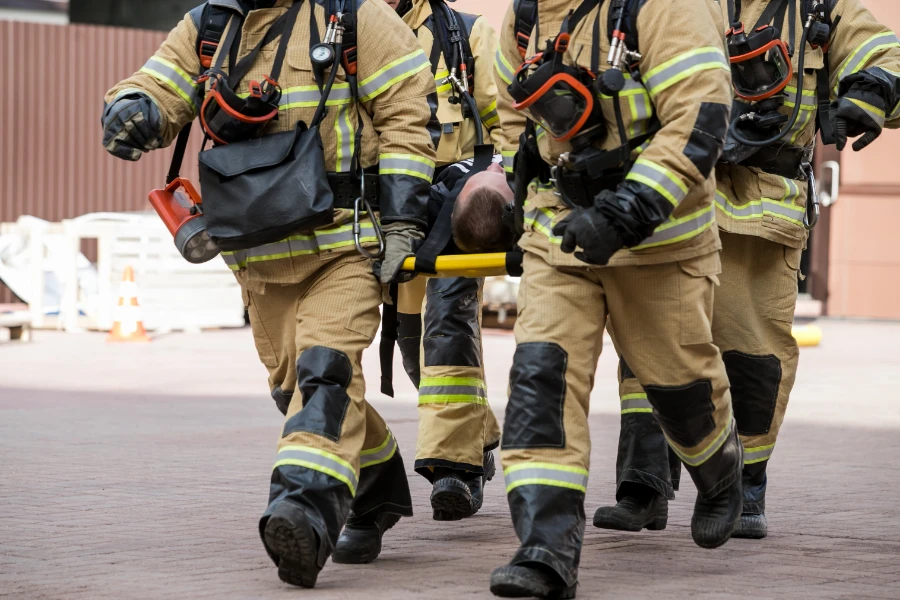The dynamic landscape of emergency medical services (EMS) increasingly recognizes the necessity for holistic approaches to patient care. Emerging cross-disciplinary training programs in 2024 are specifically designed to address this need by integrating EMS with vital disciplines such as social work and mental health. This innovative training paradigm aims to equip EMS professionals with the comprehensive skills required to manage both medical and psychosocial aspects of emergency care effectively.
The Evolution of EMS Training
Traditionally focused on immediate life-saving interventions, EMS training has undergone a transformative shift towards a more integrated care model. This evolution reflects a broader understanding that patient outcomes improve significantly when EMS professionals address both medical and emotional needs. The trend towards cross-disciplinary training is a response to this growing awareness, fostering a more adaptive and responsive EMS workforce capable of meeting diverse patient needs.
The Importance of Cross-Disciplinary Training
The integration of various disciplines within EMS training programs significantly elevates the level of patient care provided. Recognizing the frequent overlap between medical emergencies and mental health or social issues, these programs aim to prepare EMS professionals to handle complex situations with greater competence and compassion. Such training not only enhances patient care but also prepares EMS personnel to function effectively across different emergency scenarios.
Integration of Mental Health Support
Recognizing the rising incidence of mental health crises in emergency settings, cross-disciplinary programs in 2024 place a strong emphasis on mental health training. This training equips EMS professionals with the skills to identify, understand, and manage psychiatric emergencies effectively. It also includes strategies for de-escalation and communication, which are critical in managing patients experiencing mental health crises, thereby improving both patient and responder safety.
Role of Social Work in EMS
Integrating social work into EMS training addresses the crucial need for managing the broader social and environmental factors that influence patient emergencies. Social workers bring expertise in navigating community resources, family dynamics, and long-term care planning, which are invaluable when dealing with cases such as elderly falls, domestic violence, or substance abuse. This integration ensures a more comprehensive approach to emergency care, where immediate medical needs are met alongside longer-term social support.
Key Components of Cross-Disciplinary Training Programs
Effective cross-disciplinary training programs in EMS are characterized by a robust curriculum that merges traditional medical training with new competencies in mental health and social care. The curriculum is carefully designed to ensure that EMS professionals are not only proficient in advanced life support techniques but also skilled in addressing the psychosocial aspects of emergencies. This holistic approach is fundamental to modern EMS training, reflecting an all-encompassing strategy for patient care.
Training Methodologies
The methodologies employed in these training programs blend academic learning with practical experience. Classroom sessions are supplemented with realistic simulation exercises that mimic a wide range of emergency scenarios. These simulations involve actors and high-fidelity manikins, providing EMS trainees with a safe environment to apply their skills in crisis intervention, patient interaction, and medical treatment. The use of technology-enhanced learning tools further enriches the training experience, making it more engaging and effective.
Certification and Continuing Education
To ensure the highest standards of care, cross-disciplinary EMS training programs include rigorous certification processes. These certifications require both initial qualification and ongoing education to maintain proficiency in the evolving fields of healthcare. Continuing education is particularly emphasized in 2024, with a focus on keeping EMS professionals updated on the latest in clinical practices, technological advancements, and holistic care approaches. Regular workshops, seminars, and online courses make it feasible for EMS personnel to continue their professional development while actively serving in the field.
Challenges in Implementing Cross-Disciplinary Programs
Cross-disciplinary training faces several barriers, primarily financial and institutional. Funding such programs requires substantial investment, often scarce in public health sectors. Resistance from traditional EMS training entities also poses a significant challenge, as they may be hesitant to adopt new educational models that integrate mental health and social work. These challenges require innovative solutions and strong leadership to overcome resistance and secure necessary funding.
Benefits of Cross-Disciplinary Training
Integrating multiple disciplines into EMS training substantially enhances patient care and provider satisfaction. Paramedics equipped with mental health and social work skills can offer more comprehensive care, leading to better patient outcomes. Moreover, these skills make the job more varied and fulfilling, potentially reducing burnout among EMS professionals. As they expand their capabilities, they also increase their employability and career longevity in diverse health service roles.
Innovative Programs and Case Studies
2024 has seen the introduction of innovative programs like Impact EMS Training, which exemplifies the successful integration of EMS with critical care and psychological support training. This program has not only increased the competence of EMS professionals but also their confidence in handling complex situations involving mental health crises. Another example is a program in California that integrates social work interns into EMS teams, providing real-time support for patients with social or psychological needs, thus improving overall service delivery and patient satisfaction.
Global Perspectives
Internationally, the approach to EMS training varies, but the trend towards integration is clear. For example, in Sweden, cross-disciplinary training includes social workers in emergency response units, allowing for immediate holistic care. This model has inspired similar programs in Canada and Australia, where there is a growing recognition of the social determinants of health in emergency care. These global examples provide valuable lessons in the effectiveness of integrated training models and the importance of cultural adaptation.
Strategies for Successful Implementation
Successful implementation of cross-disciplinary training programs involves several key strategies. Collaboration among educational institutions, healthcare organizations, and government bodies is essential. Clearly defining the program goals and demonstrating the benefits through pilot projects can also facilitate broader adoption. Additionally, securing ongoing funding through grants or partnerships with private sectors can sustain these programs beyond their initial phases.
Future Directions in EMS Training
Looking forward, the landscape of EMS training is set to evolve dramatically. The incorporation of advanced technology, such as virtual reality simulations for scenario-based training, will likely become standard. These technologies can provide realistic and varied training environments that prepare EMS personnel for the complexity of modern emergency scenarios. Moreover, the focus on continuous professional development and adaptability will prepare EMS professionals for future challenges and innovations in patient care.
Further Considerations
The exploration of cross-disciplinary training in EMS underscores its importance in contemporary healthcare education. As the field continues to evolve, stakeholders from all sectors of health and education must engage actively in shaping future curricula. This will ensure that EMS professionals are not only skilled in medical care but also in addressing the broader health needs of their communities.
Frequently Asked Questions
The dynamic landscape of emergency medical services (EMS) increasingly recognizes the necessity for holistic approaches to patient care. Emerging cross-disciplinary training programs in 2024 are specifically designed to address this need by integrating EMS with vital disciplines such as social work and mental health. This innovative training paradigm aims to equip EMS professionals with the comprehensive skills required to manage both medical and psychosocial aspects of emergency care effectively.
What are the core psychosocial skills taught in these training programs?
Cross-disciplinary training programs in 2024 focus on developing key psychosocial skills, including effective communication, crisis intervention, and patient-centered counseling techniques. These skills enable EMS professionals to manage patients experiencing acute stress, anxiety, or mental health crises, ensuring a compassionate and effective response.
How do these programs adjust traditional EMS training to include these new disciplines?
These programs integrate new disciplines by restructuring the curriculum to include joint sessions where EMS trainees work alongside social work and mental health professionals. This collaborative approach allows for the sharing of knowledge and skills, ensuring that EMS professionals are well-prepared to handle complex, multifaceted emergency situations.
Can you describe a specific simulation exercise used in this training?
One common simulation exercise involves a scenario where EMS trainees respond to a simulated car accident involving family trauma. Trainees must assess and address both the medical injuries and the emotional distress of the victims, utilizing their training in psychological first aid and crisis management. This type of simulation helps to reinforce the importance of addressing both physical and emotional needs.
What impact have these training programs had on the quality of emergency care provided?
The impact of these cross-disciplinary training programs has been significant, with improvements noted in patient outcomes, particularly in the management of emergencies involving mental health issues. EMS professionals report feeling more confident and equipped to handle a wider range of emergency situations, leading to higher patient satisfaction and a reduction in the need for follow-up medical or psychological care.
Relevant Resources on Cross-Disciplinary EMS Training
As the demand for integrated training programs in EMS continues to grow, several reputable sources offer insights and updates on how these programs are evolving. Here are five informative resources from 2024, focusing on the integration of mental health and social work within EMS training programs:
Rural Emergency Medical Services Training | SAMHSA: Details on a SAMHSA-funded program to train EMS personnel in rural areas with a focus on substance use disorders and mental health.
EMS Mental Health Resources | NAEMT: The National Association of Emergency Medical Technicians provides resources for addressing mental health in EMS training.
Education Standards and Guidelines | EMS.gov: Official guidelines and standards for EMS education, including the integration of interdisciplinary practices.
EMS Workers | NIOSH CDC: A resource by the CDC focusing on the safety and health of EMS workers, including mental health considerations.
Education & Training | JEMS: An EMS publication that offers articles and resources on the latest training programs and strategies in EMS, including cross-disciplinary approaches.

Jeromy VanderMeulen is a seasoned fire service leader with over two decades of experience in emergency response, training, and public safety management. He currently serves as Battalion Chief at the Lehigh Acres Fire Control & Rescue District and is CEO of the Ricky Rescue Training Academy, a premier provider of online and blended EMT and firefighter certification programs in Florida.
Jeromy holds multiple degrees from Edison State College and the Community College of the Air Force, and is pursuing his MBA at Barry University. He maintains top-tier certifications, including Fire Officer IV, Fire Instructor III, and Fire Inspector II, and has served as a subject matter expert for a court case. He is a member or the Florida Fire Chiefs Association.
Jeromy also contributes to state-level fire safety regulation and serves on several hiring and promotional boards.

